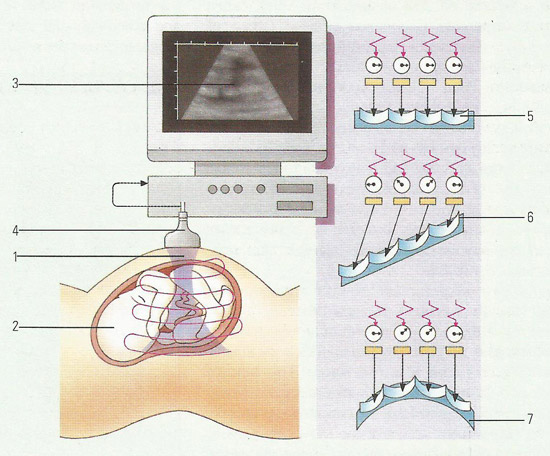ultrasonics

Ultrasonic, or ultrasound, scanners send out beams of sound (1) and read the returning echoes to build up a picture of structures below the surface (2). They are commonly used to view fetuses in the womb with the picture displayed on a real-time monitor (3). The sound waves used are above the range of human hearing and are created by piezoelectric crystals in the handset (4). These crystals change shape when the voltage is switched off. An ultrasonic scanner uses an oscillating voltage to make crystals vibrate, producing sound of the right frequency. The process is reversed when an echo hits the transducer and the sound wave is converted back into a voltage, which the monitor reads to build up an image. Each handset has dozens of the piezoelectric crystals at its face and by altering the timing of the oscillations of the voltage, the beam can be steered. When the voltage hits all the crystals at the same time a flat beam is issued (5). By sending the voltage to one end of the row of crystals before the other the beam can be steered (6). The beam of sound can also be focused by hitting the end crystals before the ones on the center (7).
Ultrasonics is the science of sound waves with frequencies above those that humans can hear (above about 20 kilohertz). With modern piezoelectric techniques, ultrasonic waves having frequencies above 24 kHz can be readily generated with high efficiency and intensity in solids and liquids, and exhibit the normal wave properties of reflection, refraction, and diffraction.
In medicine, ultrasonics are used to locate tumors, to scan fetuses (see ultrasound scanning), for medical device welding, and to treat neurological disorders. Other applications of ultrasonics include the agitation of liquids to form emulsions, detection of flaws in metals (the ultrasonic wave passed through a metal is reflected by a hairline crack), cleaning small objects by vibrating them ultrasonically in a solvent, echo sounding in deep water, and soldering aluminum. Low-power waves are used in thickness gauging and holography, high-power waves in surgery and for industrial homogenization, cleaning, and machining.


